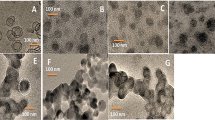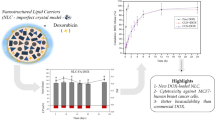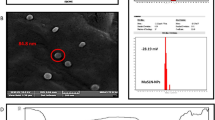Abstract
Folate-decorated monoolein (MO) cubosomes containing poly(ethyleneimine) (PEI), cinnamic acid (CA), and doxorubicin (DOX) were prepared to deliver the anticancer drug specifically to cancer cells (KB cells) and boost the anti-cancer efficacy without causing an acute toxicity. Hydrophobically modified (Hm) gelatin (Gel)-folate (FA) conjugate (HmGel-FA) was prepared through amidation reaction among Gel, decanoyl chloride, and FA. HmGel-FA and Pluronic F127 were used as stabilizers for the cubosomal particles. According to the measurement of air/water interfacial tension, the surface activity was greater in the order of HmGel > HmGel-FA > Gel. Since it was reported that PEI and CA formed a self-assembly in the water channel of cubosomes and the dissolving property of the self-assembly was dependent on the pH value of medium, they were included in the water channel as a controller for DOX release. On the TEM micrographs of the cubosomes, water channels were surrounded by MO bilayers, and the payload (i.e. PEI, CA, DOX) had little effect on the structure. The in vitro anti-cancer efficacy of folate-decorated cubosomes containing PEI, CA, and DOX was higher than that of folate-free ones. According to flow cytometric analysis and confocal laser scanning microscopy, DOX fluorescence intensity was greater in the order of KB cells treated with folate-decorated cubosomes containing PEI, CA, and DOX > folate-free ones > free DOX. The folate-decorated cubosomes would be able to target the cancer cells and subsequently the receptor-mediated endocytosis would take place.
Similar content being viewed by others
References
Seddon, J. M. and R. H. Templer (1993) Cubic phases of self-assembled amphiphilic aggregates. Philos. Trans. Phys. Sci. Eng. 344: 377–401.
Lindblom, G. and L. Rilfors (1989) Cubic phases and isotropic structures formed by membrane lipids—possible biological relevance. Biochim. Biophys. Acta. 988: 221–256.
Choi, J. H., H. Y. Lee, J. C. Kim, and Y. C. Kim (2007) Monoolein cubic phases containing hydrophobically modified poly (N-isopropylacrylamide). J. Ind. Eng. Chem. 13: 380–386.
Nazaruk, E., M. Szlęzak, E. Górecka, R. Bilewicz, Y. M. Osornio, P. Uebelhart, and E. M. Landau (2014) Design and assembly of pH-sensitive lipidic cubic phase matrices for drug release. Langmuir. 30: 1383–1390.
Negrini, R., A. Sánchez-Ferrer, and R. Mezzenga (2014) Influence of electrostatic interactions on the release of charged molecules from lipid cubic phases. Langmuir. 30: 4280–4288.
Zhang, H. and J. C. Kim (2016) Reduction-responsive monoolein cubic phase containing hydrophobically modified poly (ethylene imine) and dithiodipropionic acid. Colloids Surf. A Physicochem. Eng. Asp. 506: 526–534.
Rahanyan-Kägi, N., S. Aleandri, C. Speziale, R. Mezzenga, and E. M. Landau (2015) Stimuli-responsive lipidic cubic phase: triggered release and sequestration of guest molecules. Chemistry. 21: 1873–1877.
Zhang, H. and J. C. Kim (2016) Concentration and temperature-sensitive assembling behavior of polyethyleneimine–cinnamic acid conjugate and its release-controlling property in monoolein cubic phase. J. Ind. Eng. Chem. 36: 215–223.
Kim, J. A., D. Park, and J. C. Kim (2018) pH-sensitive self-assembling property of poly (ethyleneimine)/cinnamic acid mixture and its effect on pH-dependent release of monoolein cubic phase. Int. J. Polym. Mater. 67: 438–444.
Park, D. and J. C. Kim (2019) Monoolein cubic phases containing cinnamic acid, poly(ethyleneimine) and gold nanoparticle and their UV- and NIR-responsive release property. Int. J. Pharm. 554: 420–428.
Park, D., S. J. Lee, and J. C. Kim (2018) pH-sensitive self-assembled microspheres composed of poly(ethyleneimine) and cinnamic acid. Appl. Biochem. Biotechnol. 184: 253–263.
Park, D. and J. C. Kim (2017) UV light and thermo-sensitive disassembling and release property of the assembly of cinnamic acid and poly(ethyleneimine). Soft Mater. 15: 282–291.
Allen, T. M. (2002) Ligand-targeted therapeutics in anticancer therapy. Nat. Rev. Cancer. 2: 750–763.
Toffoli, G., C. Cernigoi, A. Russo, A. Gallo, M. Bagnoli, and M. Boiocchi (1997) Overexpression of folate binding protein in ovarian cancers. Int. J. Cancer. 74: 193–198.
Guo, H. and J. C. Kim (2015) Upper critical solution temperature behavior of cinnamic acid and polyethyleneimine mixture and its effect on temperature-dependent release of liposome. Int. J. Pharm. 494: 172–179.
Sudimack, J. and R. J. Lee (2000) Targeted drug delivery via the folate receptor. Adv. Drug Deliv. Rev. 41: 147–162.
Matsuda, M., M. Ueno, Y. Endo, M. Inoue, M. Sasaki, and T. Taguchi (2012) Enhanced tissue penetration-induced high bonding strength of a novel tissue adhesive composed of cholesteryl group-modified gelatin and disuccinimidyl tartarate. Colloids Surf. B Biointerfaces. 91: 48–56.
Caffrey, M. (1987) Kinetics and mechanism of transitions involving the lamellar, cubic, inverted hexagonal, and fluid isotropic phases of hydrated monoacylglycerides monitored by time-resolved x-ray diffraction. Biochemistry. 26: 6349–6363.
Zhao, X. Y., J. Zhang, L. Q. Zheng, and H. L. Dong (2005) Studies of cubosomes as a sustained drug delivery system. J. Dispers. Sci. Technol. 25: 795–799.
Driever, C. D., X. Mulet, A. P. R. Johnston, L. J. Waddington, H. Thiisen, F. Caruso, and C. J. Drummond (2011) Converging layer-by-layer polyelectrolyte microcapsule and cubic lyotropic liquid crystalline nanoparticle approaches for molecular encapsulation. Soft Matter. 7: 4257–4266.
Hassan, F., A. P. R. S. Islam, M. M. Mu, H. Ito, N. Koide, I. Mori, T. Yoshida, and T. Yokochi (2005) Lipopolysaccharide prevents doxorubicin-induced apoptosis in RAW 264.7 macrophage cells by inhibiting p53 activation. Mol. Cancer Res. 3: 373–379.
Pan, X. Q., A. P. R. H. Wang, and R. J. Lee (2003) Antitumor activity of folate receptor-targeted liposomal doxorubicin in a KB oral carcinoma murine xenograft model. Pharm. Res. 20: 417–422.
Nakagawa, K., A. P. R. S. Iwamoto, M. Nakajima, A. Shono, and K. Satoh (2004) Microchannel emulsification using gelatin and surfactant-free coacervate microencapsulation. J. Colloid Interface Sci. 278: 198–205.
Toledano, O. and A. P. R. S. Magdassi (1998) Emulsification and foaming properties of hydrophobically modified gelatin. J. Colloid Interface Sci. 200: 235–240.
Zhang, Y., A. P. R. N. Kohler, and M. Zhang (2002) Surface modification of superparamagnetic magnetite nanoparticles and their intracellular uptake. Biomaterials. 23: 1553–1561.
Ghosh, P., A. P. R. G. Han, M. De, C. K. Kim, and V. M. Rotello (2008) Gold nanoparticles in delivery applications. Adv. Drug Deliv. Rev. 60: 1307–1315.
Schmidt, H. H., A. P. R. T. D. Warner, M. Nakane, U. Förstermann, and F. Murad (1992) Regulation and subcellular location of nitrogen oxide synthases in RAW264.7 macrophages. Mol. Pharmacol. 41: 615–624.
Alle, M., B. reddy G, T. H. Kim, S. H. Park, S. H. Lee, and J. C. Kim (2020) Doxorubicin-carboxymethyl xanthan gum capped gold nanoparticles: Microwave synthesis, characterization, and anti-cancer activity. Carbohydr. Polym. 229: 115511.
Acknowledgments
This research was supported by the Basic Science Research Program through the National Research Foundation of Korea (NRF) funded by the Ministry of Education (NRF-2015R1D1A1A01057279) and Basic Science Research Program through the National Research Foundation of Korea (NRF) funded by the Ministry of Education (No. 2018R1A6A1A03025582).
The authors declare no conflict of interest.
Neither ethical approval nor informed consent was required for this study.
Author information
Authors and Affiliations
Corresponding author
Additional information
Publisher’s Note Springer Nature remains neutral with regard to jurisdictional claims in published maps and institutional affiliations.
Rights and permissions
About this article
Cite this article
Park, D., Park, S.H. & Kim, JC. In vitro Anti-cancer Efficacy and Cellular Interaction of Cubic Phases Containing Cinnamic Acid, Poly(ethyleneimine), and Doxorubicin. Biotechnol Bioproc E 25, 235–245 (2020). https://doi.org/10.1007/s12257-019-0123-5
Received:
Revised:
Accepted:
Published:
Issue Date:
DOI: https://doi.org/10.1007/s12257-019-0123-5




